If you’ve ever dreamed of gazing at the night sky filled with stars and constellations, Pennsylvania is the place to be. The state is known for having some of the darkest skies on the Eastern Seaboard, offering a serene and picturesque backdrop for memorable stargazing experiences. From its state parks to the vast expanses of the Pennsylvania Wilds, there is no shortage of awe-inspiring locations for amateur and professional stargazers alike.
Pennsylvania’s premier stargazing spots offer a variety of opportunities for everyone, regardless of their level of experience or equipment available. Whether you’re looking to capture the perfect shot of the Milky Way or observe a meteor shower, the breathtaking night sky and Pennsylvania’s unique geographical location make it an unbeatable destination for stargazing enthusiasts.
In a nutshell
- Pennsylvania offers exceptional stargazing experiences due to its dark skies and unique locations. It’s one of the best stargazing spots in the US.
- Various spots cater to amateur and professional stargazers, providing memorable nights of observation.
- Seasonal events like meteor showers make Pennsylvania a must-visit destination for astronomy enthusiasts.
In this article, you get to
Explore: Discover Pennsylvania’s 25 best stargazing spots, including state parks and scenic vistas.
Learn: Unveil the allure of Pennsylvania’s stargazing opportunities, from witnessing the Milky Way’s brilliance to observing meteor showers.
Understand: Understand why Pennsylvania’s unique geographical location and dark skies make it an unbeatable destination for stargazing enthusiasts.
Identify: Identify premier stargazing locations, such as Cherry Springs State Park, Cowan’s Gap State Park, and French Creek State Park.
Plan: Learn how to plan your stargazing adventures with tips on weather checking, location selection, and using star maps and apps.
Experience: Immerse yourself in the distinct seasons of stargazing, from crisp winter skies with constellations like Orion to summer’s Perseid meteor shower.
Connect: Join local astronomy clubs to connect with fellow stargazers, access resources, and learn from professional astronomers.
Equip: Understand different types of telescopes, including refractors, reflectors, and Dobsonian telescopes, and their suitability for beginners.
Prepare: Use the Clear Sky Chart tool to plan your stargazing outings and enhance your chances of optimal visibility.
Practice Etiquette: Learn stargazing etiquette and tips, from protecting your night vision with red light to respecting quiet and darkness in observing areas.
By the end of this article, you’ll have a comprehensive understanding of Pennsylvania’s top stargazing spots, be equipped with practical tips for successful observation, and be inspired to embark on unforgettable stargazing adventures under the Keystone State’s breathtaking night skies.
Let’s dive right in.
The Allure of Pennsylvania Stargazing
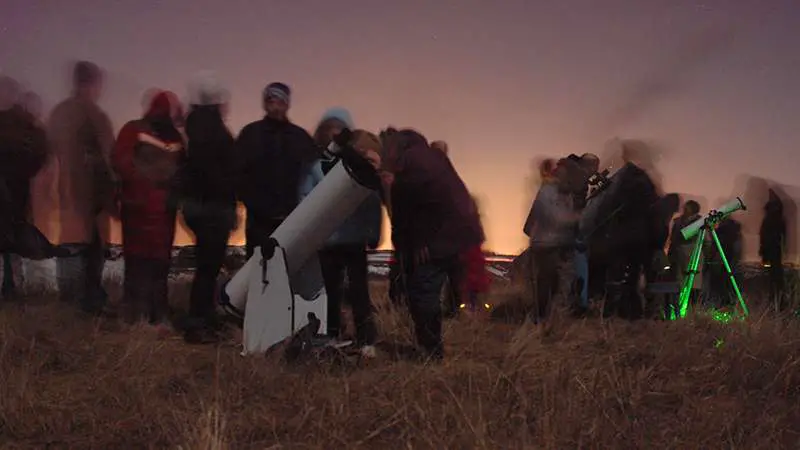
Thanks to its vast stretches of dark skies, Pennsylvania is a stargazer’s paradise. You can marvel at the twinkling stars, witness the mesmerizing colors of the Milky Way, or watch meteor showers streak across the night sky. Let’s dive into why Pennsylvania is a perfect location for stargazing.
Firstly, Pennsylvania is home to several stargazing spots with exceptionally dark skies. Dark skies are essential for enjoying an unobstructed view of celestial wonders. Some of the popular stargazing locations in Pennsylvania include:
- Cherry Springs State Park
- Sproul State Forest
- Raccoon Creek State Park
At these locations, the lack of light pollution lets you spot constellations, asteroids, and even the captivating Aurora Borealis (a.k.a Northern Lights) on certain nights.
Another factor that contributes to the allure of Pennsylvania stargazing is the numerous events and resources available to both amateur and seasoned stargazers. For example, public sky watches at Canoe Creek State Park provide attendees with guided experiences to view the stars, planets, and the moon.
To enhance your Pennsylvania stargazing experience, consider these actionable tips:
- Choose a location with minimal light pollution, like those previously mentioned.
- Check the weather forecast for clear skies.
- Use star maps and astronomy apps to help you identify celestial bodies.
- Dress warmly and bring a blanket or chair for comfortable stargazing sessions.
As a stargazing enthusiast, you’ll find Pennsylvania an exceptional destination for admiring the vast wonders of the night sky. So, grab a telescope or lie back and let your eyes wander across the celestial tapestry. Remember to make a wish when you see a shooting star!
FREE STARGAZING CHECKLIST
My 5-page Stargazing Checklist will enhance your astronomical observations.
Follow this free checklist to navigate the night sky with confidence, clarity, and a sense of preparedness for a rewarding stargazing experience.

Pennsylvania’s Premier Stargazing Locations
I’ve compiled a list of the 25 best stargazing Pennsylvania has to offer. In this section I briefly provide you with an overview of each spot, including what you can enjoy during the day, and what makes each location unique.
The 25 Best Pennsylvania Stargazing Spots
- Cherry Spring State Park
- Cowan’s Gap State Park
- Delaware Water Gap
- French Creek State Park
- Greenwood Furnace State Park
- Highpoint Scenic Vista
- Kettle Creek Scenic View
- Laurel Hill State Park
- Lebo Vista
- Lyman Run State Park
- Michaux State Forest
- Mingo Creek Park Observatory
- Moraine State Park
- Naylor Observatory
- Ohiopyle State Park
- Pine Grove Furnace State Park
- Prince Gallitzin State Park
- Promised Land State Park
- Raystown Lake
- Ryan Observatory
- Sproul State Forest
- Susquehannock State Forest
- The Franklin Institute
- Wagman Observatory
- Weiser State Forest
Cherry Springs State Park
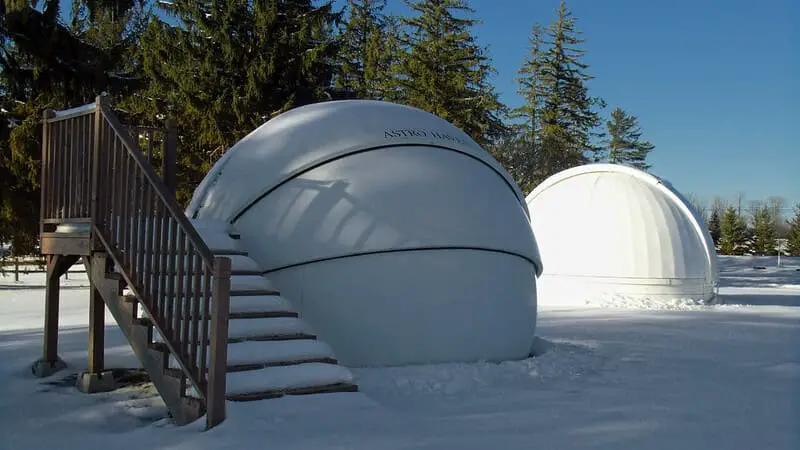
Cherry Springs State Park is Pennsylvania’s most famous stargazing spot, and it’s perfect for your stargazing adventure.
During the day, you can enjoy the beauty of its 48 acres of nature.
At night, this park transforms into an ideal location for you, whether you’re an amateur or professional astronomer. Appreciate the darkness and clarity of the night sky as you gaze at celestial wonders.
As the state’s only official “Dark Sky Park,” Cherry Springs is committed to countering light pollution seriously.
Throughout the year, numerous stargazing events await you here. The park provides facilities like observation decks and an astronomy field.
Keep an eye on the weather forecast for the best conditions. Engage with the local astronomy community, which often hosts events enhancing your journey. Personally, I remember feeling a sense of wonder as I gazed upon the Milky Way at Cherry Springs State Park.
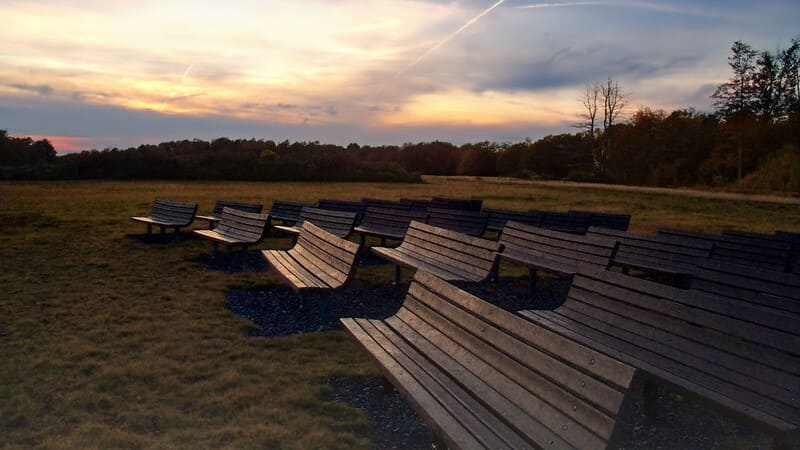
Here’s more info about Cherry Springs State Park to deepen your appreciation for this celestial haven:
- Astrophotography Paradise: Cherry Springs isn’t just about observing the night sky; it’s also a prime spot for capturing its splendor. With its incredibly dark skies and minimal light pollution, the park provides astrophotographers with a canvas to capture stunning images of stars, planets, and even deep-sky objects like galaxies and nebulae. Imagine capturing the Milky Way arching overhead, with its rich tapestry of stars adorning your photographs.
- Starry Events and Festivals: Throughout the year, Cherry Springs hosts various stargazing events and festivals. These gatherings bring together astronomy enthusiasts from all walks of life, creating a sense of community under the starlit sky. From meteor showers to planet sightings, these events offer you a chance to learn from experts, share your passion, and revel in the wonders above.
- Embrace the Darkness: Cherry Springs State Park takes its role as a Dark Sky Park seriously. Its dedication to minimizing light pollution ensures an environment where you can truly immerse yourself in the depths of the universe. The park enforces strict lighting regulations, creating a setting where your eyes can adapt to the darkness and unveil the full spectrum of celestial delights.
- Celestial Diversity: Beyond the captivating beauty of the Milky Way, Cherry Springs offers you a chance to observe a range of celestial phenomena. From the dance of planets like Jupiter and Saturn to the ethereal glow of the Andromeda Galaxy, the park’s pristine skies present you with a diverse array of objects to explore.
- Meteorological and Astronomical Data: Cherry Springs boasts an online Clear Sky Chart that provides real-time meteorological and astronomical data. This tool helps you plan your stargazing adventure by offering information about cloud cover, transparency, and seeing conditions. Use this valuable resource to optimize your visits and increase your chances of witnessing the night sky in all its glory.
- Stargazing Amenities: Cherry Springs State Park offers facilities designed with stargazers in mind. The Night Sky Public Viewing Area features designated spaces for setting up telescopes, ensuring optimal conditions for your observations. Enjoy the convenience of this dedicated space as you unfold your telescope and explore the universe.
- Immerse Yourself in Workshops: Consider participating in workshops held at Cherry Springs. These educational sessions provide insights into astronomy techniques, astrophotography, and celestial navigation. Learning from experts enhances your connection with the night sky and equips you with skills to make the most of your stargazing experiences.
Cowan’s Gap State Park

Set in Fulton County, Cowan’s Gap State Park invites you to explore its lake and beach area by day. As night falls, it transforms into an inviting spot for you to observe the night sky. Clear skies and low light pollution here create excellent stargazing conditions. Delight in the tranquil atmosphere and breathtaking views await you as a stargazing enthusiast.
For your best stargazing experience, seek out nights with minimal moonlight. The park offers a peaceful escape for you to connect with the cosmos. Basic facilities are available, including restrooms and picnic areas. Prioritize checking the weather forecast to ensure optimal conditions.
Delaware Water Gap
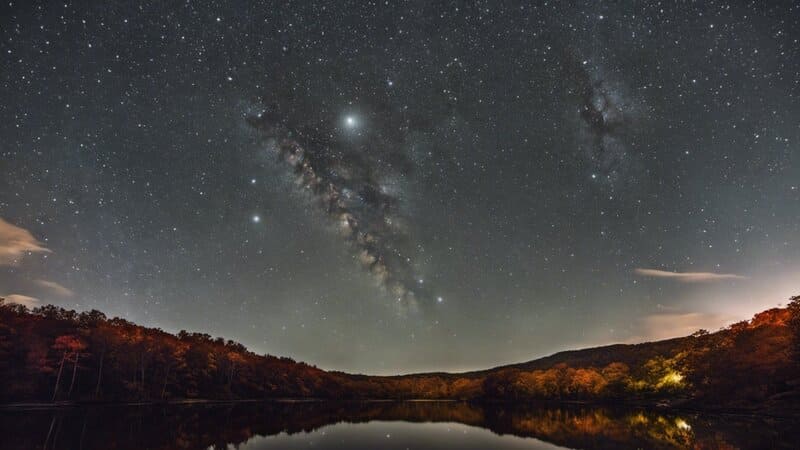
Discover the scenic landscapes of the Delaware Water Gap, straddling Pennsylvania and New Jersey. During the day, explore waterfalls, hiking trails, and river activities. As the sun sets, open spaces beckon you to escape urban lights and indulge in stargazing.
French Creek State Park

In Berks and Chester Counties, French Creek State Park offers daytime delights like hiking and camping. At night, it transforms into an incredible stargazing site just for you. The park’s natural darkness and limited light pollution provide a canvas for observing celestial wonders. The park offers hiking trails and camping sites.
Greenwood Furnace State Park
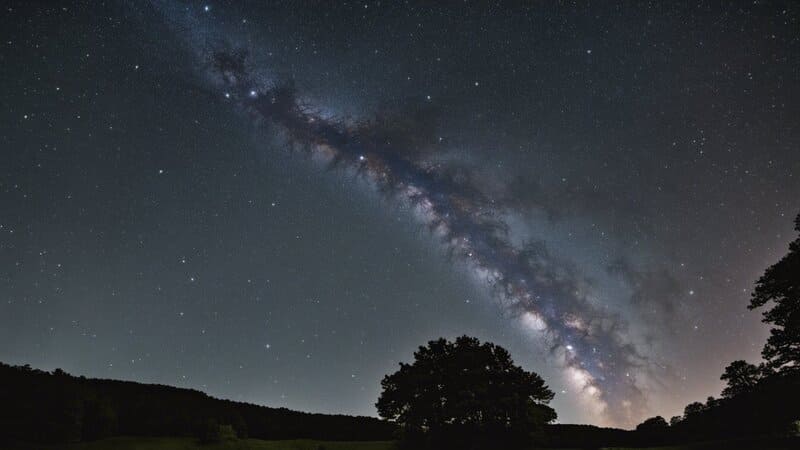
Greenwood Furnace State Park, nestled in Central Pennsylvania, provides a range of daytime activities, from hiking to swimming. As night falls, this park becomes an incredible location for you to explore the night sky. The absence of city lights and clear skies make it an attractive spot for stargazing. This serene and quiet atmosphere enhances your experience as you gaze at celestial wonders.
Highpoint Scenic Vista
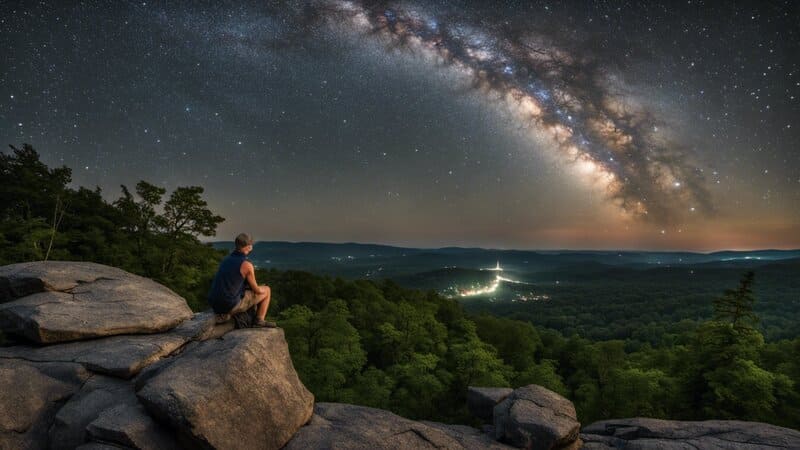
Indulge yourself with the breathtaking daytime view from Highpoint Scenic Vista in York County.
When night arrives, this elevated spot becomes your prime destination to observe the sky. Thanks to its elevated position and minimal light pollution, you can enjoy panoramic views of the horizon, making it perfect for you to experience celestial wonders.
Kettle Creek Scenic View

In the heart of the Pennsylvania Wilds, Kettle Creek Scenic View treats you to picturesque views during the day. As night falls, this remote spot becomes your haven as a stargazer. The absence of city lights creates a dark and pristine sky, enhancing your experience of the cosmos. Whether you’re an astronomy enthusiast or just curious, the appeal of this site is undeniable.
The best times for your stargazing adventure are on nights with clear skies and minimal light pollution. Remember to dress warmly and check the weather forecast for your celestial escapade.
Laurel Hill State Park
During the day, Somerset County’s Laurel Hill State Park invites you to enjoy its lake and sandy beach. When night arrives, this park becomes an enchanting spot for you to gaze at the clear night sky. Its minimal light pollution ensures optimal conditions for observing stars, planets, and celestial objects. Remember to dress warmly and bring essentials for a comfortable night outdoors.
Lebo Vista
Lebo Vista, near Centralia, offers expansive daytime views of the landscape. When darkness descends, this elevated location is tailor-made for your stargazing journey. The absence of light pollution allows you to witness breathtaking celestial views. Make the most of this beautiful site for a memorable stargazing experience.
Lyman Run State Park
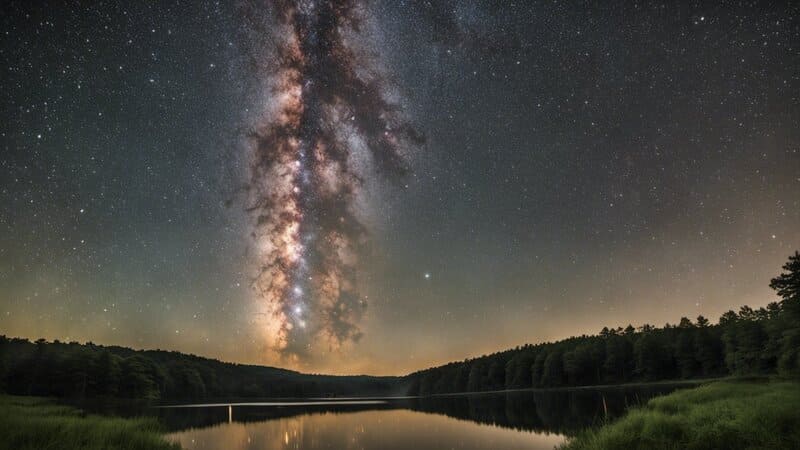
In Potter County, Lyman Run State Park offers a variety of daytime activities, including hiking, fishing, and boating. As the sun sets, the park’s clear, open spaces provide the perfect atmosphere for you to indulge in stargazing.
The park’s remote location ensures minimal light pollution, allowing for excellent views of the night sky. Watch for stargazing events hosted in the park or by local astronomy clubs.
My own memories of stargazing at Lyman Run State Park are filled with wonder and a sense of connection to the universe.
Michaux State Forest

Located in south-central Pennsylvania, Michaux State Forest offers beautiful scenery for you to explore during the day. By night, it transforms into a prime stargazing location. The forest’s dark skies and limited light pollution create an optimal environment for you to observe the wonders of the cosmos.
The tranquil forest setting adds to the experience, allowing you to immerse yourself in the celestial landscape. Check the weather forecast for clear skies before embarking on your stargazing adventure.
Mingo Creek Park Observatory
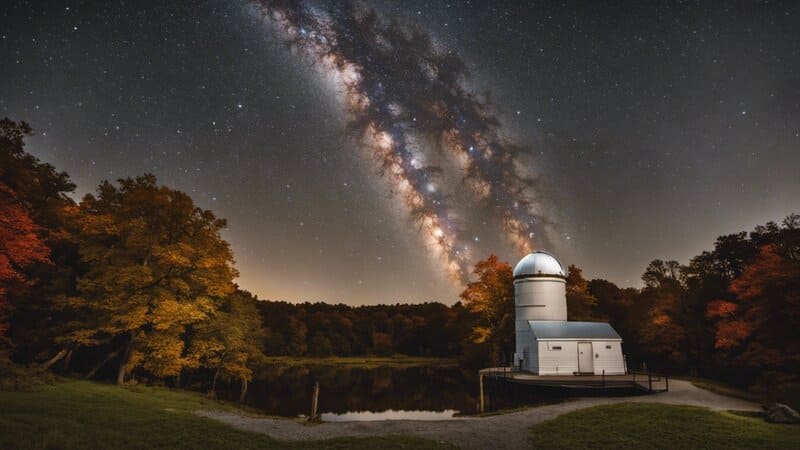
Situated in southwestern Pennsylvania, Mingo Creek Park Observatory is your gateway to both daytime activities and nighttime stargazing. The park’s dark skies and regular stargazing events at the observatory offer an excellent place to learn and experience the mysteries of the night sky.
Take advantage of this location’s educational opportunities to enhance your stargazing adventure.
The observatory provides access to advanced telescopes, enabling you to explore celestial wonders in detail. Engaging with the local astronomy community can deepen your appreciation and understanding of the universe.
Moraine State Park
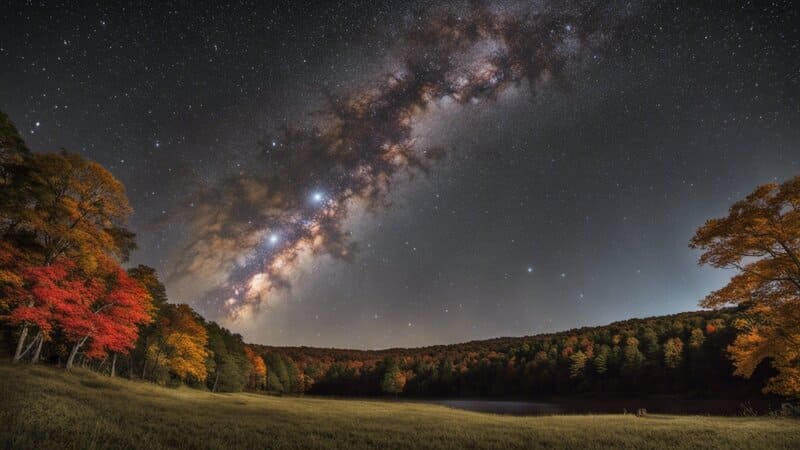
Set in western Pennsylvania, Moraine State Park invites you to enjoy various outdoor activities during the day. As night falls, the park’s dark skies, free from light pollution, create an inviting environment for you to stargaze. The serene and spacious surroundings provide a perfect setting to observe and appreciate the celestial sights above.
Naylor Observatory

Located near Harrisburg, Pennsylvania, Naylor Observatory offers daytime tours and hosts public stargazing events in the evenings, providing you with a chance to explore the wonders of the cosmos.
Its hilltop location offers stunning panoramic views, making it an excellent spot for your stargazing adventure. The observatory’s multiple telescopes allow you to observe celestial objects in detail. Engage with knowledgeable staff and fellow enthusiasts to deepen your understanding of the night sky and its mysteries.
Ohiopyle State Park
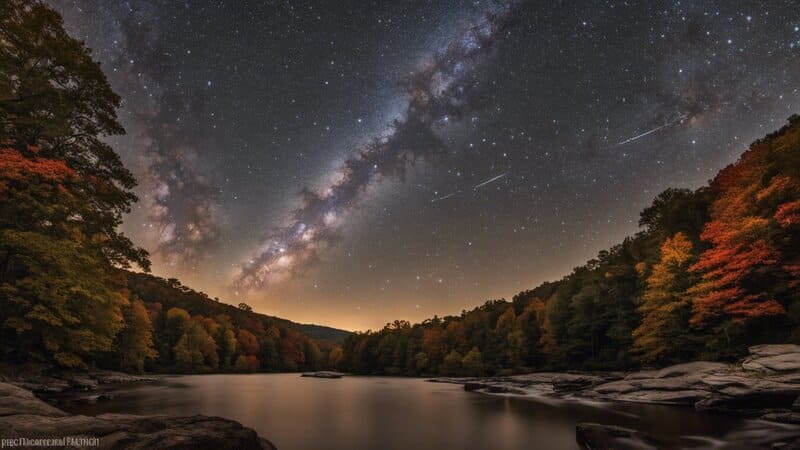
In southwestern Pennsylvania, Ohiopyle State Park offers various outdoor activities during the day. As night descends, its dark skies and remote setting make it an excellent spot to escape light pollution and immerse yourself in stargazing. The peaceful environment provides a captivating backdrop for observing celestial wonders.
Pine Grove Furnace State Park

Nestled in south-central Pennsylvania, Pine Grove Furnace State Park offers an array of daytime activities. By night, it transforms into an exceptional stargazing location, thanks to its dark skies and limited light pollution. The park’s serene atmosphere makes it a perfect spot for you to contemplate the wonders of the night sky.
Prince Gallitzin State Park
Prince Gallitzin State Park, situated in central Pennsylvania, provides various outdoor activities during the day. The park is known for its dark skies and limited light pollution, making it an optimal spot for your stargazing adventure. The peaceful surroundings provide a perfect setting for immersing yourself in the celestial landscape.
Promised Land State Park
Located in northeastern Pennsylvania, Promised Land State Park offers several daytime outdoor activities. By night, its dark skies and remote location make it an ideal spot for you to indulge in stargazing. Whether you’re an astronomy enthusiast or a casual observer, the tranquil environment provides a serene backdrop for your celestial exploration.
Raystown Lake
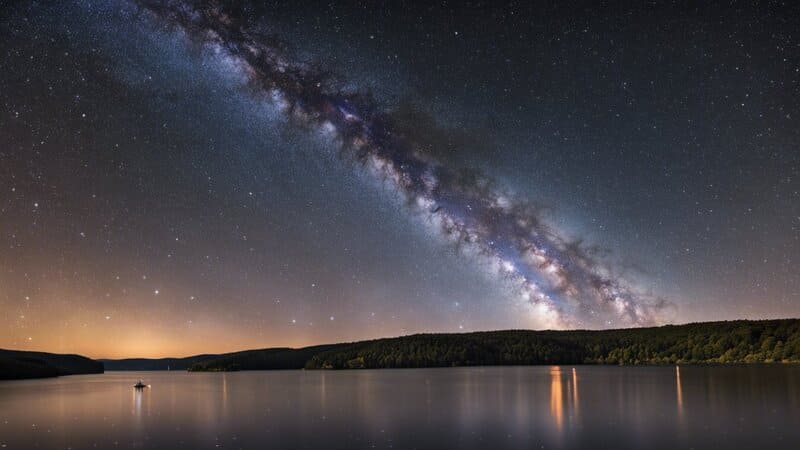
Raystown Lake, situated in central Pennsylvania, offers a range of outdoor activities during the day, such as boating and fishing. By night, its dark skies make it an ideal location for you to enjoy stargazing. The calm and reflective waters of the lake add a unique dimension to your stargazing experience, allowing you to appreciate the celestial splendor from a different perspective.
Ryan Observatory
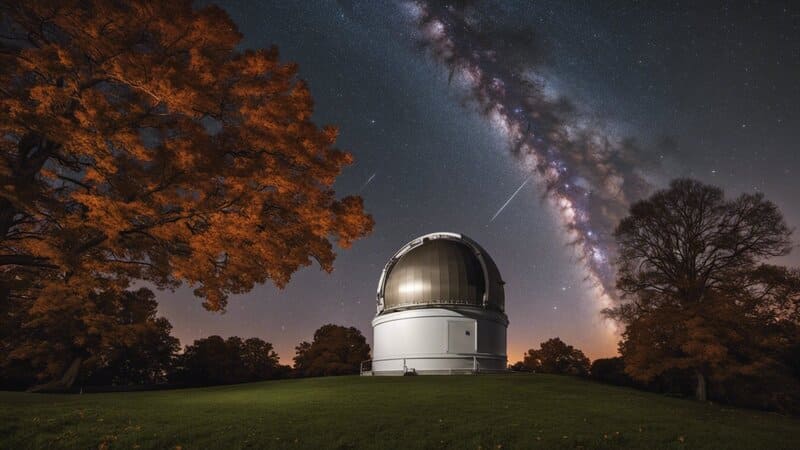
Near Pittsburgh, Ryan Observatory is an excellent spot for your stargazing adventure due to its high elevation and advanced technology. The observatory opens to the public during select events, providing rare access to high-quality telescopes. This exceptional location allows you to observe celestial wonders in vivid detail. Engage with knowledgeable staff and fellow enthusiasts to deepen your understanding and appreciation of the cosmos.
Sproul State Forest

Sproul State Forest, located in north-central Pennsylvania, offers daytime outdoor activities and magnificent stargazing opportunities. Its dark skies and natural surroundings provide the ideal environment for you to appreciate the majesty of the night sky. The forest’s remote setting offers a serene space for your celestial-focused escape.
Susquehannock State Forest

In northern Pennsylvania, Susquehannock State Forest provides various daytime activities and excellent stargazing conditions. Its dark skies and remote location make it perfect for observing celestial wonders. The peaceful forest setting offers an escape from city lights and a chance for you to connect with the night sky.
The Franklin Institute
Located in Philadelphia, The Franklin Institute is a hub of exploration and education, offering engaging exhibits and a unique stargazing experience at the Joel N. Bloom Observatory. The observatory, named in honor of Joel N. Bloom, provides you with a rooftop vantage point for observing the night sky in the heart of the city. Amidst the urban environment, this is a distinctive opportunity to explore the cosmos.
Joel N. Bloom Observatory
The Joel N. Bloom Observatory hosts events that allow you to peer through telescopes and gain insights into celestial wonders under the city lights. These events offer a chance for you to connect with experienced astronomers who will guide you through the mysteries of the universe. Engaging programs and educational offerings at The Franklin Institute make it an excellent place to deepen your understanding of astronomy and stargazing.
Wagman Observatory
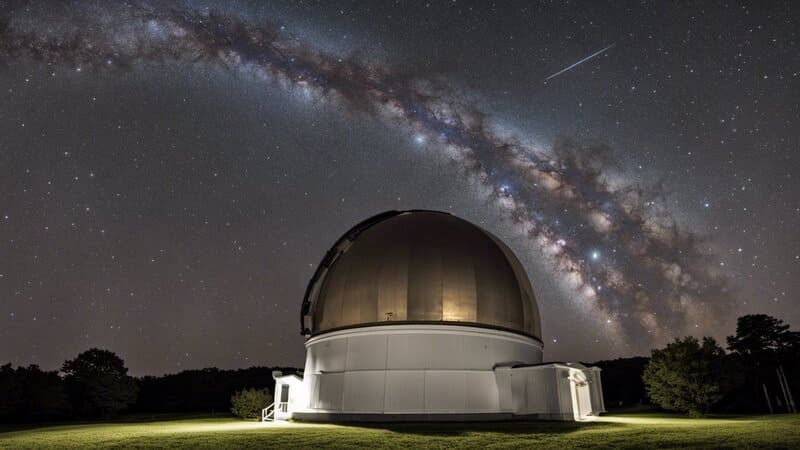
Situated near Pittsburgh, Wagman Observatory is a prime location for your stargazing adventure due to its advanced telescopes and knowledgeable staff. The observatory hosts public events, providing you with access to incredible celestial views. Its hilltop location offers an ideal setting to appreciate the wonders of the night sky.
Weiser State Forest

In eastern Pennsylvania, Weiser State Forest offers daytime outdoor activities and exceptional stargazing opportunities. The forest’s dark skies, natural surroundings, and limited light pollution make it an ideal spot for you to observe celestial phenomena. The tranquil forest setting ensures a memorable and serene stargazing experience.
Free Google Map of the Best Stargazing in Pennsylvania
Here’s your free Google Map of the Pennsylvania Stargazing Spots highlighted in this article.
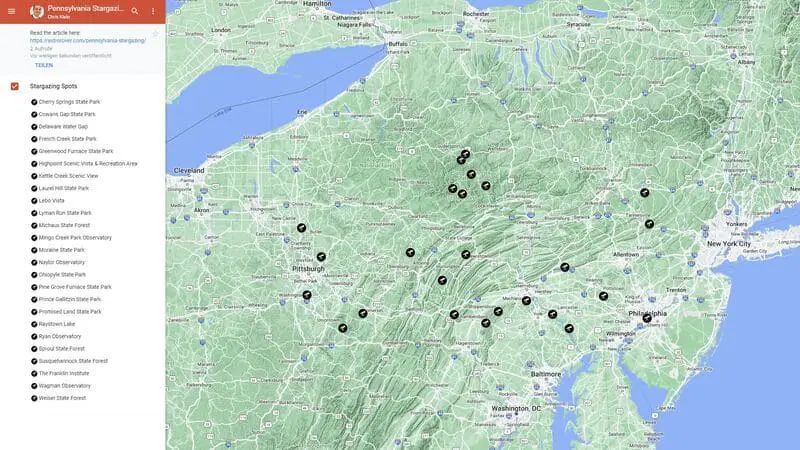
Stargazing Seasons in Pennsylvania
Winter Stargazing
During the winter months, stargazing in Pennsylvania offers crisp, clear skies, perfect for observing constellations and other celestial objects. Cold temperatures minimize atmospheric disturbance, providing excellent viewing conditions.
Key highlights of winter stargazing include:
- Orion constellation
- Taurus and the Pleiades star cluster
- Geminid meteor shower (observed in December)
However, remember to dress warmly and bring a thermos with a hot beverage to stay comfortable during those chilly winter nights!
Spring Stargazing
Spring stargazing in Pennsylvania brings pleasant temperatures and longer days. With warmer weather, you can enjoy the night sky more comfortably.
Some spring stargazing events worth catching are:
- Lyrid meteor shower (around late April)
- Leo constellation
- Virgo and its bright star, Spica
Pack a light jacket or blanket when you head out for a springtime sky-watching session.
Summer Stargazing
Summer is the perfect time to venture out for stargazing in Pennsylvania. Warmer nights and more predictable weather ensure comfortable viewing conditions.
During summer, your celestial attractions include:
- Perseid meteor shower (peak around mid-August)
- Milky Way
- Summer Triangle (consisting of Vega, Deneb, and Altair)
Remember to bring a comfortable chair or blanket, and relax while enjoying the beauty of the summer sky.
Fall Stargazing
As summer turns to fall, Pennsylvania’s night skies remain ideal for stargazing. The autumn months offer cooler temperatures and striking celestial sights.
Fall points of interest:
- Leonid meteor shower (observed in mid-November)
- Andromeda Galaxy (visible with binoculars or a small telescope)
- Great Square of Pegasus
For a delightful fall evening, bring a cozy blanket and enjoy the crisp autumn air under the star-filled sky.
Professional Astronomers and Stargazing
As an amateur astronomer in Pennsylvania, you’re in the perfect place to learn from professional astronomers. One way to access their expertise is by joining the Astronomical Society of Harrisburg. This club hosts events, workshops, and stargazing sessions where you can connect with fellow astronomy enthusiasts and experts.
Here are three key benefits of such clubs:
- Learning: You’ll learn about the night sky, telescope usage, and the science of astronomy.
- Networking: Make friends who share your passion for stargazing and learn from their experiences.
- Resources: Access specialized equipment, such as telescopes and observatories that may otherwise be unavailable to you.
Two popular stargazing spots in Pennsylvania that might interest professional astronomers and stargazing lovers alike are Cherry Springs State Park and Ohiopyle State Park. Cherry Springs is a Dark Sky Park, which makes it ideal for observing the Milky Way, planets, and other celestial phenomena, while Ohiopyle State Park offers dark skies and an excellent opportunity for overnight camping to marvel at the constellations.
When you plan your stargazing adventure, remember these tips to make the most of your experience:
- Check the forecast: Find a night with clear skies for the best visibility of celestial objects.
- Pack properly: Bring blankets, chairs, binoculars or a telescope, and a red flashlight to preserve your night vision.
- Patience is key: Take your time to let your eyes adjust to the darkness, and you’ll be rewarded with a breathtaking view of the night sky.
In summary, Pennsylvania offers fantastic resources and locations for professional astronomers and amateur stargazers alike. By tapping into the local astronomy community and visiting the state’s remarkable stargazing spots, you will surely have an unforgettable experience under the stars.
Stargazing Tools
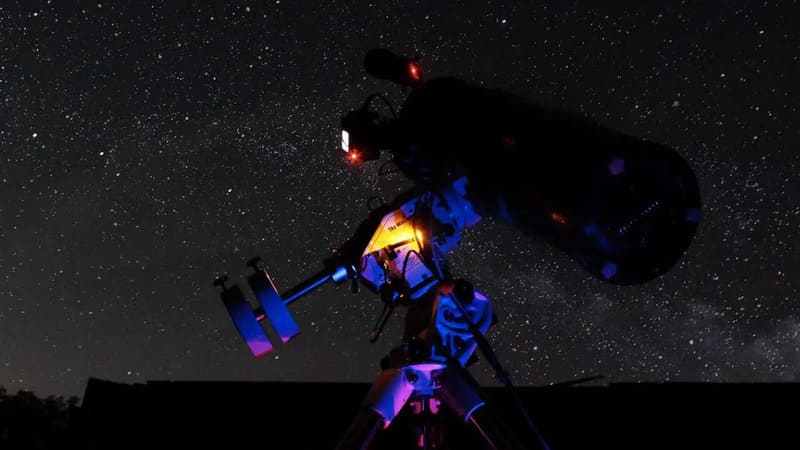
Telescopes
Regarding stargazing in Pennsylvania, having the right telescope can greatly enhance your experience. You don’t need a fancy, expensive model to start with.
There are three basic types of telescopes suitable for beginners:
- Refractor telescopes: Affordable and easy to use, these telescopes have lenses that focus light to deliver clear images.
- Reflector telescopes: A little more advanced, they use mirrors instead of lenses and offer bright images even for distant celestial objects.
- Dobsonian telescopes: These are reflector telescopes on a simple, sturdy mount, designed for easy movement and targeting.
For any telescope, consider its portability and compatibility with camera attachments for astrophotography. Remember, observing celestial objects is more enjoyable when you have a telescope that’s easy to use and comfortable for your eyes.
Clear Sky Chart
Timing is crucial for stargazing, and a clear sky chart can help you plan ahead. This handy tool shows how clear and dark the sky will be in your area at specific hours based on factors such as cloud cover, light pollution, and atmospheric transparency. To use this tool, follow these simple steps:
- Visit a clear sky chart website (such as cleardarksky.com) and enter your location.
- Study the cloud, darkness, and transparency rows of the chart.
- Look for the best combination of clear skies and dark hours (ideally with high transparency) to maximize your stargazing experience.
Keep these additional tips handy to further enhance your stargazing endeavors:
- Red light: Preserve your night vision using red light instead of regular white light when stargazing. Red light doesn’t cause pupils to shrink as much, so you can adjust your eyes to the darkness.
- Observing locations: Choose lesser-known stargazing spots, like Mingo Creek Park Observatory or Coudersport, to avoid light pollution and crowded areas. Pennsylvania has plenty of fantastic locations for observing the night sky.
With the right tools and tips, you’ll be well-prepared for your stargazing adventure in Pennsylvania. Enjoy your journey among the stars!
Overnight Astronomy: Public Viewing Areas and Lodging
If you’re looking for the perfect spot to stargaze in Pennsylvania, look no further than the Overnight Astronomy Observation Field at Cherry Springs State Park. As a designated dark sky park, it offers minimal light pollution, allowing you to see stars, constellations, and even the Milky Way with the naked eye. Remember to reserve your spot in advance, as space is limited.
The park also features the Night Sky Public Viewing Area for those who only want to stargaze for a few hours. While white light is allowed in this area, it’s recommended to use a flashlight with a red filter or cover to preserve your night vision.
Regarding lodging, Cherry Springs State Park offers rustic campsites for a truly immersive stargazing experience. Just don’t forget to reserve your campsite ahead of time. If camping isn’t your thing, there are several nearby hotels, bed and breakfasts, and cabin rentals.
Here are a few options:
- The Potato City Country Inn
- Frosty Hollow Bed & Breakfast
- The Castle Bed & Breakfast
- Kettle Creek Adventures Lodge
For the best stargazing experience, consider visiting during a new moon or meteor shower, like the Perseid Meteor Shower in August. Keep an eye on the weather, too: You’ll want clear, cloudless skies to enjoy the full beauty of the stars.
Stargazing Etiquette and Tips
Prepare for a starry night: When planning your stargazing trip in Pennsylvania, consider visiting a registered Gold Level Dark Sky Park, such as Cherry Springs State Park, and viewing night skies with minimal light pollution. Remember to check the lunar phase for the darkest skies, and dress appropriately for cool and damp weather.
Protect your night vision: Did you know that red light preserves night vision? To keep your eyes adjusted to the dark, cover your flashlight with red cellophane or use a red lens. If you have an illuminated display, activate the red light option.
Choose the right equipment: Although 7 x 50 binoculars are popular for stargazing, 7 x 35 binoculars work fine for beginners. When you visit a park, feel free to bring the following:
- Blankets
- Chairs
- A telescope or binoculars
- Snacks
Follow stargazing etiquette:
- Keep noise levels low to respect others in the park
- Arrive early to set up your equipment and find a good viewing spot
- Turn off electronic devices, as their screens emit bright light
- If you need help, ask fellow stargazers or park staff politely
By following these etiquette rules and tips, you’ll ensure everyone can enjoy Pennsylvania’s stunning dark skies.
Frequently Asked Questions
Where can I see the Milky Way in Pennsylvania?
The Milky Way is visible from several locations in Pennsylvania, but the best place for an unobstructed view is Cherry Springs State Park. This park is known for its exceptionally dark skies and minimal light pollution, making it ideal for observing the galaxy.
What are the best stargazing spots near Philadelphia?
Several great options near Philadelphia for stargazing, such as French Creek State Park and Marsh Creek State Park. Both parks offer relatively darker skies compared to the city, and with just an hour’s drive, you can escape the light pollution and enjoy the stars.
Can you visit Cherry Springs State Park without a reservation?
Yes, you can visit Cherry Springs State Park without a reservation during the daytime. However, if you’re planning to stay overnight for stargazing, it’s highly recommended to make a reservation to secure your spot, as camping and observing areas can fill up quickly.
What is the darkest place for stargazing in PA?
Cherry Springs State Park is the darkest place for stargazing in Pennsylvania. The park is known for its lack of light pollution, making it one of the darkest locations on the East Coast and ideal for observing celestial objects.
Are there any good stargazing locations in Michaux State Forest?
Michaux State Forest offers suitable stargazing spots due to its relatively dark skies and remote location. For the best experience, head deeper into the forest, away from any sources of light pollution, to enjoy the beauty of the night sky.
What are the top stargazing locations near New Jersey?
If you’re looking for stargazing locations near New Jersey, consider visiting the nearby Pennsylvania state parks like Nockamixon State Park or Hopewell Furnace National Historic Site. These parks offer darker skies, away from the bright lights of major cities, allowing for a better stargazing experience.
Summary: Stargazing Pennsylvania
Thank you for reading my article on Pennsylvania Stargazing.
Pennsylvania is a remarkable destination for stargazing enthusiasts, with dark skies and various parks. Some top spots for observing the night sky include Cherry Springs State Park, Sproul State Forest, Pine Grove Furnace State Park, and Canoe Creek State Park. These locations offer unobstructed views of the stars, planets, and constellations.
When you visit these stargazing locations, remember to bring a blanket, warm clothing, and some snacks to fully enjoy the experience. Don’t forget to turn off your phone or put it on “night mode” to preserve your night vision. You can use free star maps or apps to navigate the skies and identify celestial objects.
So, grab your friends, family, or that special someone and head out to one of Pennsylvania’s amazing stargazing spots. Whether you’re an amateur astronomer or a seasoned stargazer, you’ll be amazed by the beauty of the night sky in the Keystone State.
Happy stargazing!
Read my other articles in my Best Stargazing in US series:
- Best stargazing in Arizona
- Best stargazing in California
- Best stargazing in Colorado
- Best stargazing in Florida
- Best stargazing in Hawaii, and on the Hawaiian Islands of Kauai, Oahu, and Maui
- Best stargazing in Maine
- Best stargazing in Nevada
- Best stargazing in New Mexico
- Best stargazing in New York
- Best stargazing in North Carolina
- Best stargazing in Oklahoma
- Best stargazing in Ohio
- Best stargazing in Oregon
- Best stargazing in Texas
- Best stargazing in Utah




